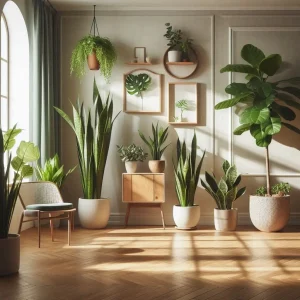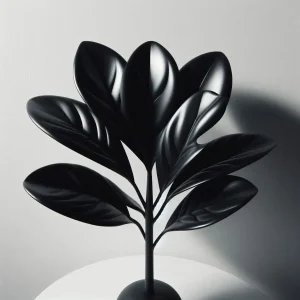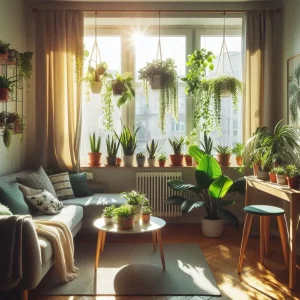For every household who loves keeping plants to enjoy their beautiful presence, there is a hidden concern regarding the safety of their cats around plants. Therefore pet owners try to choose their houseplants between pet-friendly greens to maintain their health. The following article is about 45 cat safe houseplants which will guarantee their safety.
The Complete Guide to Buy Cat Safe Houseplants
Page Contents
ToggleIn this article we will read about plants which won’t cause your cats any harm according to your lifestyle, lighting conditions, home space to make sure our pets are enjoying the plants alongside us.
We will read about the plants, their needs and guidance to take care of them.
List of cat safe houseplants
Spider Plant (Chlorophytum comosum)
Spider plants are famous for their adaptability and air-purifying ability, they are the perfect choice for beginners as they are easy-to-grow, they are not sensitive to different lighting conditions and doesn’t need extra caring and occasional watering. The Spider Plant is not toxic to cats.
Boston Fern (Nephrolepis exaltata)
The Boston Fern is an elegant and evergreen plant that prefers high humidity, indirect light and cold temperatures. They are perfect for bathrooms and kitchens. Boston Ferns are perfect for cats as well as humans because they are famous for their removing air toxins.
African Violet (Saintpaulia)
African Violets have soft petals with dark green leaves which would create a beautiful decoration. They prefer indirect light and has to be watered with normal or room-temperature water. They make your home colorful and are completely safe for your cats.
Bamboo Palm (Chamaedorea seifrizii)
The Bamboo Palm can make your living room tropical with its beauteous leaves. They stay alive in bright, filtered lighting as well as an occasional watering that lets the soil to dry out between waterings. Additionally, they filter out both benzene and trichloroethylene, two common household toxins.
Cast Iron Plant (Aspidistra elatior)
The Cast Iron Plant is a adaptive plant like its name. They can stand low light, not frequent watering, not stable temperatures. They are the perfect floor plants. Cast Iron Plants are non-toxic and a safe choice for homes with cats.
Venus Flytrap (Dionaea muscipula)
The Venus Flytrap is a suitable plant for bright lighted places with moist soil. They are carnivorous plants which feeds on pests. They are completely safe for cats.
Zebra Plant (Haworthiopsis attenuata)
Like their name, Zebra plants has white banded leaves Which resemble zebras. They enjoy sun’s lighting and need minimal watering. They are the perfect decorative item for houses as well as being safe for cats.
Orchids (Various Species)
They have various species to pick from. Orchids enjoy indirect light with humid environment. If they are well-cared they would have a long lifespan. They are safe for cats and a beautiful decoration for your home.
Parlor Palm (Chamaedorea elegans)
The Parlor Palm is an excellent choice for cat owners, they are safe for cats, air cleaners, easy to care as they stay alive in low light and high humidity. They are small plants which would fit into smaller spaces.
Peperomia (Peperomia spp.)
Peperomia plants have different appearances and they come in various sizes. They can have heart-shaped leaves or rounded ones. They mostly survive in indirect light and not many waterings. They purify air and are safe for cats.
Swedish Ivy (Plectranthus verticillatus)
Swedish Ivy comes from the mint family. They survive in indirect light as well as in medium light, they prefer moist soil but also not too much watering. They can be hanged in baskets, have fast growing and are completely safe for pets like cats. So if you are wondering about Buying a pet friendly plant, Swedish Ivy is the perfect choice for you.
Calathea (Calathea spp.)
Calathea zebrina or Calathea makoyana, two species of the Calathea family, or any other type of this plant might be the perfect choice for you. It has a variety of kinds which each of them has different leaf patterns and colors. They prefer indirect light and high humidity. Can be kept in bathrooms or kitchen with a window. Their leaves open up and close down during a day. They are safe for cats and pet-friendly.
Money Tree
This plant is considered lucky in some cultures. It has large and shining leaves. Money tree survives in indirect but bright light, need a sufficient amount of water, however if they consume too much water, their roots can rot. They are non-toxic to cats.
Haworthia (Haworthia spp.)
Haworthias are the great option for small places because they themselves are small. They have leaves with architectural like elements. Also They are easy to care, need indirect light and doesn’t need much watering. If you own a cat and doesn’t have much time to put extra care for your plant, Haworthia is the great option for you.
Rattlesnake plant (Calathea lancifolia)
The reason they are named Rattlesnake plant is that they have long and wavy leaves with lots of patterns and textures. They survive in indirect light and high humidity. Perfect for bathrooms. Not toxic to animals especially cats.
Areca Palm (Dypsis lutescens)
The Areca Palm or Butterfly Palm is a air cleaner and pet-friendly plant with tropical atmosphere. They survive in indirect light and need a sufficient amount of water.
Maidenhair Fern (Adiantum)
The Maidenhair Fern survive in high humidity with moist soil, prefer shady spot and not direct light. They have fan shaped leaves and need attention and extra efforts to stay alive. They are cat friendly plants.
Christmas Cactus (Schlumbergera bridgesii)
The Christmas Cactus is a cat friendly plant which prefers indirect light and a medium amount of water. They usually bloom during holidays and the reason they are named Christmas cactus is because of this.
Ponytail Palm (Beaucarnea recurvata)
Because of their shapes and leaves which resembles ponytail they are named Ponytail Palm. They need bright light and can survive without any water. They are Cat friendly and give a beautiful view to your home.
Prayer Plant (Maranta leuconeura)
The Prayer Plant is famous for it’s habit of folding leaves upright at night like it’s praying. They survive in indirect light and high humidity and are safe for cats.
Bird’s Nest Fern (Asplenium nidus)
Bird’s Nest Fern survive in medium to low light and high humidity. Soil has to be kept moist. Since it is considered as a safe plant it is a great option for any cat owner household.
Wax Plant (Hoya carnosa)
The Wax Plant, also known as Hoya has star shaped flowers with wide and glassy leaves. They have to be kept in indirect light, they can survive lack of water, doesn’t need extra care, therefore they are suitable for people who are busy or forgot to water their plants. They are also safe for cats.
Staghorn Fern (Platycerium bifurcatum)
This plant requires bright and indirect light and has to be watered in it’s own special way like soaking or misting. They grow on other trees and their leaves look like antlers. Also they are completely safe for cats.
Polka Dot Plant (Hypoestes phyllostachya)
The Polka Dot Plant has white, pink or red mottleds on its leaves, therefore they can give a unique look to your house. They require indirect light with humid environment. They have to be watered frequently. Polka Dot is safe for pets like cat.
Bromeliads (Bromeliaceae family)
Bromeliads have flowers with long lasting age. They don’t need much attention so with minimum care you can easily have a pet friendly plant at your home. They only need indirect light and watering in their central cup.
Button Fern (Pellaea rotundifolia)
The Button Fern needs moderate to bright indirect light with a watering routine. They are completely safe for your cats and can freshen your place with their green and round leaves.
Lipstick Plant (Aeschynanthus radicans)
The lipstick plant resembles a lipstick because of their tubular flowers beside its dark and shiny leaves. They need indirect light and humidity. Between each watering sessions their soil has to get slightly dry. They are completely safe for cats along with their unique presence for your home.
Moth Orchid (Phalaenopsis spp.)
The Moth Orchid is famous for it’s lasting flowers beside being an easy to care plant. They need indirect light with high humidity and sufficient watering. Moth Orchids are beautiful decorations as well as being safe for pets like cat.
Blue Echeveria (Echeveria glauca)
Blue Echeveria has blue-green leaves with symmetrical shapes. They can stand dryness, need bright light. They have to be watered when their soil is dried. They can give your home a Unique look along with being a cat friendly plant.
Fittonia (Fittonia albivenis)
Fittonia or the Nerve Plant has different shading colors in their leaves like white, red and green. They need high humidity and indirect light and occasional watering. Can be a perfect choice for bathrooms and terrariums. They are also non toxic to cats.
Christmas Palm (Adonidia merrillii)
The Christmas Palm has clusters of red berries which only appears in winter. It is a tropical plant that needs indirect light with occasional watering. However be careful not to over water it as it can cause the root to rot. They are harmless to pets like cats.
Kimberly Queen Fern (Nephrolepis obliterata)
The Kimberly Queen Fern is somehow similar to The Boston Fern in terms of appearance. They need indirect light along with high humidity. They purify the air and are non-toxic to cats as well as giving your home a fresh look.
Banana Plant (Musa spp.)
The Banana Plant requires a big space for its large leaves, they grow fast and can give your place a tropical atmosphere. They have to be kept in bright light with sufficient watering. Also they are completely safe for cats as they are non-toxic.
Baby Rubber Plant (Peperomia obtusifolia)
The Baby Rubber Plant is a Peperomia Variety with high tolerance to lighting situations and prefer low light, their soils have to get dried out between watering sessions. They have spoon shaped thick leaves. They don’t require special care and are safe for cats.
Burro’s Tail (Sedum morganianum)
The Burro’s tail has blue-green leaves and are suitable for hanging baskets. The enjoy being in indirect light, doesn’t need a lot of watering. They are completely safe for cats and give your home a Unique presence.
Ponytail Palm (Beaucarnea recurvata)
The ponytail palm has a palm like appearance, they have a unique appearance and doesn’t need much attention. They don’t need much watering and can stand dryness. They need indirect light and are completely safe for cats.
Kentia Palm (Howea forsteriana)
The Kentia Palm has an elegant presence with its shapes. They need indirect light, however they can also tolerate much lower lighting levels. They are non-toxic to cats and would give your home a fresh, elegant and tropical touch.
Lace Flower Vine (Alsobia dianthiflora)
The Lace Flower Vine has tiny delicate white flowers. They need indirect light with occasional watering. They are safe for cats and if you are concerned about their health this plant is a great option for you.
Goldfish Plant (Nematanthus spp.)
The Goldfish Plant has gotten its name from its appearance. They have orange and fish-shaped flowers. They prefer indirect light along with high humidity, has to be watered regularly. They are completely safe for cats and will give your home a colorful presence.
Peacock Plant (Calathea makoyana)
The Peacock Plant has leaves with patterns which resembles a Peacock’s tail. They need indirect light with high humidity. They are the best option for keeping at bathrooms and kitchens along with their non toxicity for pets like cats.
Spiderwort (Tradescantia zebrina)
The spiderwort is also another easy-to-grow plant and a great option for beginners as they don’t need much caring. They can tolerate a wide range of lighting conditions like both indirect light and partial shade. They need to be in moist environments. They have a fast growth and can be propagated from cuttings. They are safe for cats and can make your home more colorful with their delicate flowers.
Pilea Peperomioides (Chinese Money Plant)
The Pilea Peperomioides has a unique round shaped leaves on its long petioles. They have a modern look and can make your house look stylish. They need to be in bright locations with indirect light. They shouldn’t be over watered. Also they will maintain your cats health.
Watermelon Peperomia (Peperomia argyreia)
The Watermelon Peperomia has silver and green striped leaves that looks like the rind of a watermelon like its name. They don’t require much space as they are small. They enjoy being in medium to bright indirect light. And as for watering, their soil needs to dry out between each watering sessions. They are also harmless to cats.
Prayer Plant (Maranta leuconeura)
The Prayer Plant has a unique look with leaves that look like painting, they got their name because of the way the leaves fold themselves up at evenings. They need low to medium lighting along with high humidity and needs to be watered every one to two week. Prayer Plants can purify the air and are safe for pets like cats. Also, they can freshen up your house!
String of Hearts (Ceropegia woodii)
The string of hearts, also known as Rosary Vine, a chain of hearts and also hearts on a string is a beautiful plant with heart shaped leaves. They love being in bright but indirect lights, are easy to care and fast growers. They shouldn’t be over watered. They are perfect for hanging baskets, which would liven up your home. They are completely pet friendly and are totally safe for cats.
Common Houseplants and The Possibility of being toxic
Some people might think all houseplants can not be harmful for their cats since they all purifies the air and sometimes their beautiful appearance will trick both people and animals and they think they are not toxic or harmful. For example the lush leaves of a peace lily or an azalea with its delicate flowers which would add a green and fresh look to any environment, can cause mild nausea to dangerous health problems in cats. We have to know what makes a plant cat friendly or what kind of toxins some plants can have that shouldn’t be bought if you have a cat.
How to Spot Cat Safe Houseplants and Tips to Identifying them
If you are wondering about Buying a cat friendly plant it is best to choose from a vet approved list. ASPCA is an official and reliable source if you are wondering how to find those lists. You have to consider that Identifying harmless plants for your cats is a skill which is not enough by reading labels by your self. Also you have to consider that even you own a non toxic plant, it doesn’t mean completely harmless. For example, If your cat eats a large amount of leaves it can cause mild discomfort. You have to choose something that would have a harmony with yourself and your pets even if you have a curious cat.
How to Grow and Care for your Cat Safe Houseplants
Watering and Feeding
Each plant requires different routines of watering and feeding. Sometimes over watering and forgetting to water your plants at all can have the same effect. It is important to do a research before buying a plant, knowing its needs and watering levels.
Secondly you have to pick the right fertilizer in the right time for your plant.
Conditions of Light and Temperature
Plants enjoy being in the correct lighting situation just like any other alive creature. However, they have a level of tolerance against the amount and intensity of lights which can be very different from plant to plant.
Another factor is temperature, some plants prefer tropical like temperature, on the other hand some needs to stay in cooler conditions.
Keeping Plants Out of Cats’ Reach and Prevention Methods
You have to know that even if you have a cat safe plant which is free of toxins, there might be a chance that your cat would eat your plants. In this case you will lost both your plant and the health of your cat. So it is wise to keep them out of your pets reach. You can put them in baskets, use plant stands, or any other strategic placements.
Some Common Problems and Possible Solutions
Dealing with Pests and Diseases in Cat Safe Plants
Houseplants always have the potential to get damaged by pests and diseases and no matter how strong they look, they will be affected by their attack. So by prevention and correct timing you can prevent the issue.
Tip: don’t forget to use cat friendly products or natural remedies as they can be effective and are safer for pets.
What to Do if Your Cat ingests a plant
Even if you have a cat friendly plant at home you have to be aware of the potential risk of plant poisoning. If they sallow your plant there is a chance of getting mild digestions. If you are suspicious about your cat eating a plant, monitor how they are acting, contact with your veterinarian and consult with them.
Some Suggestions for Your Cat Safe Plants as Home Decor
Using Plant Stand and Wall Mounts
Wall mounts and tall plant stands are both functional as they prevent cats from reaching to them and also stylish at the same time which would give your home an elegant look.
Making a Cat Friendly Plant Zone
By designing certain areas for your plants, your cats can explore the home without any risk as they are kept in their own area, plants are safe and are isolated in a specific location. It can also give your home a fresh decoration.
To Sum Up
As it was mentioned before, there is a complete list of cat friendly plants, from Spider Plants to the heart shaped String of Hearts, which would give you a broad range of options to match your taste and environment. Also you can easily have your favorite plant along with your cat and be ensured that their safety is protected. By understanding the needs and caring of both your plant and your pet, you can create a harmony in your home.
At the end, we’d like to ask you to take a look at the article Toxic Plants for Cats so you can effectively protect this beloved furry companion. Feel free to share your thoughts in the comments section.







